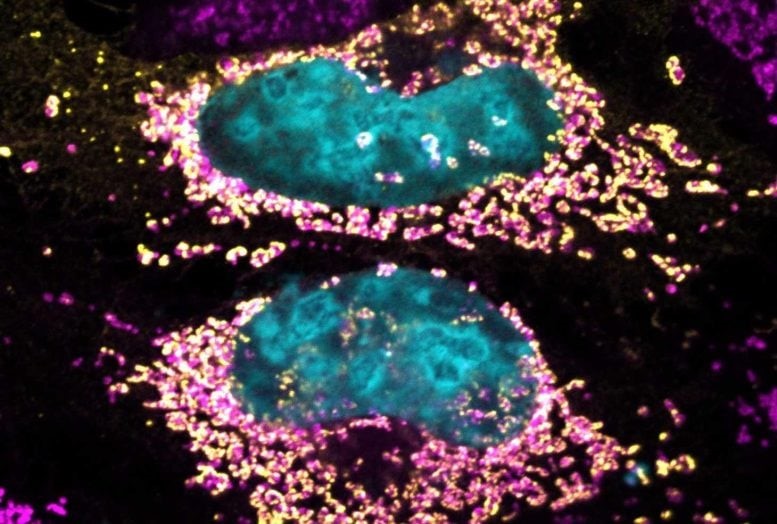Description

Disclaimer: Copyright infringement not intended.
Context
- In a groundbreaking discovery, researchers at the University of São Paulo, in collaboration with Australian counterparts, have unearthed a previously unknown protein with antioxidant properties produced by the Gram-negative intracellular bacterium, Coxiella burnetii.
Details
- The newfound protein, dubbed Mitochondrial Coxiella Effector F (MceF), demonstrates a unique ability to preserve the health of human cells, even under heavy bacterial loads.
- This revelation holds promise for innovative treatments in realms ranging from autoimmune disorders to cancer, shedding light on mitochondrial dysfunction, a key player in various diseases.
- Mitochondria, the cellular powerhouses responsible for energy production, are indispensable for biochemical reactions within cells.
- Dysfunctional mitochondria are implicated in various disorders, making them a focal point for scientific exploration.
C.burnetii's Strategies for Cell Survival
- C.burnetii, the causative agent of Q fever, has evolved sophisticated strategies to thrive within host cells.
- One such strategy involves the release of MceF, a protein that modulates Glutathione Peroxidase 4 (GPX4), an antioxidant enzyme residing in mitochondria.
- This interaction enhances mitochondrial function, preventing oxidative damage and cell death, especially when the bacterium replicates within mammalian cells.
Implications for Disease and Therapeutics
- Mitochondrial Dysfunction-Linked Diseases: The discovery of MceF opens avenues for understanding and potentially treating diseases associated with mitochondrial dysfunction, including cancer and autoimmune disorders.
- Innovative Treatment Approaches:The ability of MceF to redirect GPX4 to mitochondria, acting as a potent antiox idant, offers a novel approach to mitigate cellular aging and damage during bacterial infection. This could inspire the development of innovative therapeutic strategies.
Introduction to Proteins
- Proteins are complex and versatile biomolecules that play a fundamental role in the structure and functioning of living organisms.
- Proteins are composed of amino acids, each consisting of a central carbon atom bonded to an amino group, a carboxyl group, a hydrogen atom, and a distinctive side chain.
- Amino acids link together through peptide bonds, forming long chains. These chains fold into specific shapes, guided by the sequence of amino acids, creating the unique structure and function of each protein.
.jpg)
Protein Structure:
- Primary Structure: The linear sequence of amino acids in a protein is termed its primary structure. This sequence is genetically determined and serves as the foundation for higher levels of structural complexity.
- Secondary Structure: Proteins often exhibit secondary structures like alpha helices and beta sheets, resulting from hydrogen bonding patterns between amino acids in the polypeptide chain.
- Tertiary Structure: The three-dimensional folding of the entire protein chain, influenced by interactions between amino acid side chains, defines its tertiary structure. This level of organization contributes to the overall function.
- Quaternary Structure: Some proteins consist of multiple polypeptide chains. The arrangement of these chains in relation to each other forms the quaternary structure, influencing the protein's functionality.
Functions of Proteins:
- Enzymatic Activity: Proteins act as catalysts, facilitating biochemical reactions crucial for metabolism. Enzymes, a subclass of proteins, speed up these reactions.
- Structural Support: Structural proteins like collagen provide strength and support to tissues, contributing to the integrity of skin, bones, and connective tissues.
- Transport and Storage: Proteins, such as hemoglobin, transport gases like oxygen in the blood. Others, like ferritin, store essential ions within cells.
- Cellular Communication: Signaling proteins, like hormones and receptors, play a vital role in cellular communication, regulating processes such as growth and immune response.
Proteins in Disease and Medicine:
- Malfunctions in proteins can lead to diseases. Examples include misfolded proteins in neurodegenerative disorders and mutations in tumor suppressor proteins in cancer.
- Understanding protein structures has led to the development of therapeutic drugs targeting specific proteins. Monoclonal antibodies, for instance, are used in cancer treatment.
Introduction to Bacteria
- Bacteria, microorganisms belonging to the domain of prokaryotes, represent one of the oldest and most diverse forms of life on Earth.
- Found in various environments, bacteria play crucial roles in nutrient cycling, human health, and industrial applications.
Bacterial Cell Structure:
- Cell Envelope: The cell envelope consists of the cell wall and cell membrane. The cell wall provides structural support, and the cell membrane regulates the passage of molecules into and out of the cell.
- Cytoplasm and Nucleoid: The cytoplasm houses the bacterial DNA in a region called the nucleoid. Bacterial DNA is a singular, circular chromosome that lacks a membrane-bound nucleus.
- Ribosomes: Bacteria contain smaller ribosomes compared to eukaryotes, contributing to the synthesis of proteins within the cytoplasm.
- Flagella and Pili: Some bacteria possess flagella for movement, while pili aid in adherence to surfaces and facilitate the exchange of genetic material.
Bacterial Metabolism:
- Energy Production: Bacteria exhibit diverse metabolic pathways. Some are photosynthetic, using light energy, while others are chemoautotrophic or chemoheterotrophic, obtaining energy from chemical compounds.
- Nutrient Cycling: Bacteria play a crucial role in nutrient cycling, breaking down complex organic compounds into simpler forms, making nutrients available to other organisms.
Bacteria in Human Health:
- Gut Microbiota: The human gut harbors a diverse community of bacteria that aid in digestion, produce vitamins, and contribute to the immune system.
- Pathogenic Bacteria: While many bacteria are beneficial, some are pathogens causing diseases. Understanding bacterial pathogenesis is crucial for developing strategies to combat infections.
- Bacteria can rapidly evolve, leading to antibiotic resistance. Understanding these mechanisms is crucial for developing new antibiotics and combating drug-resistant strains.
Biotechnological Applications:
- Fermentation: Bacteria are extensively used in industrial processes, such as fermentation in the production of foods like yogurt and cheese.
- Bioremediation: Certain bacteria can detoxify pollutants and contaminants, offering potential solutions for environmental cleanup.

Conclusion
As science unravels the mysteries of cellular signaling, programmed cell death, and mitochondrial function through the lens of C. burnetii, the prospect of innovative treatments for a spectrum of diseases becomes increasingly tangible.
|
PRACTICE QUESTION
Q. While many bacteria are beneficial, some are pathogens causing diseases. Understanding bacterial pathogenesis is crucial for developing strategies to combat infections. Discuss. (250 Words)
|















